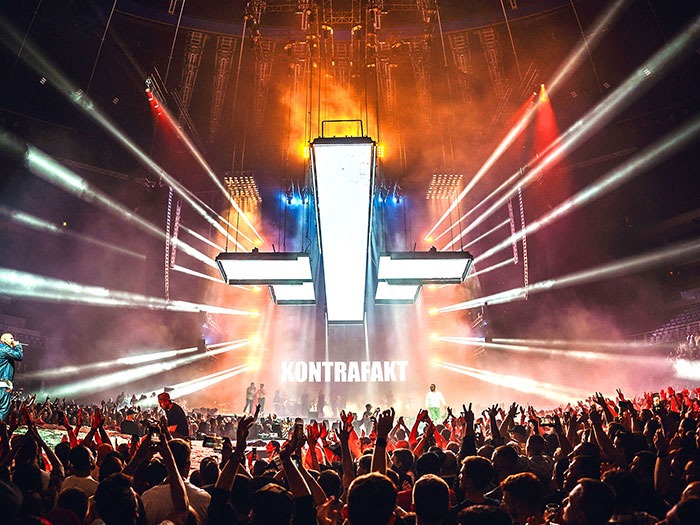Show Designer and Director Martin Hruska created a performance space for Slovak rap group Kontrafakt for their “New Era” concerts at Prague’s O2 Arena in the Czech capital, this was achieved with the assistance of nearly 200 Robe moving lights.
The Robe fixtures included a mix of 51 FORTES, 24 MegaPointes, 57 Pointes, 44 Tetra2 LED moving battens and 10 Tetra1s and three BMFL FollowSpots, supplied by leading Slovakian company Ministry Rental. Lighting was programmed and run for the show by Lighting Designer Lukáš Patzenhauer.
Hruska had a blank and proposed a multi-layered stage set with a ground-based section that was shaped like Kontrafakt’s asymmetric signature symbol with two crosses. Above this, was a 14 metre long by 10-metre-wide flown catwalk that could fly in and out at strategic points in the show.
He also considered how lights needed to be rigged in relation to the envisioned set piece movements, and with all these aspects in mind, he drew up the initial technical drawings including a lighting plot. Once the outline design and its visual requirements were established, Kontrafakt’s production manager Cyril Hořánek became involved. He looked at the design, the logistics, the budgeting and started sourcing the various supply companies needed to realise the project.
Ministry Rental was confirmed as the lighting, audio, and LED screen supplier early on, and both Hruska and Patzenhauer were therefore very happy to work with their Robe moving lights.
“I am a big fan of Robe,” stated Hruska, “As a Czech – obviously – I am proud to see the company being so innovative and becoming established as a leading global brand with a great reputation and an amazing selection of products.”
The Robe fixtures were all chosen for their “power, flexibility and appropriateness to the show and the dramaturgy,” noted Martin, who was joined on the project by Design Assistant, Michal Szozda.
36 of the FORTES were rigged on a grid of nine upstage-downstage orientated trusses flown above the main stage, all moving in and out on the same Kinesys automation system that was controlling the flown runway system. Different parts of this were lowered and raised to allow artist access and scenic movement at strategic moments in the show.
The other FORTES were positioned six on a front truss in the ‘advanced’ position, with four more each on the left and right-side trusses. All these FORTES were in prime positions to catch all the on-runway action as Kontrafakt and special guests.
A MegaPointe was rigged on each of the 9 ‘grid’ trusses in the same position as the two most downstage rows of FORTES, and this was to produce a fan of narrow, piercing light rays coming from the very top of the 23-metre lighting trim.
MegaPointes were also dotted around on the stage deck, the thrust, and the flown catwalk.Additional MegaPointes on the static side trusses blasted in as a horizontal grid.
Robe Pointes were interspersed between all these positions on a downstage truss together with blinders, and on the side trusses augmenting the beam-work of the MegaPointes, generally assisting in expanding the feeling of depth and ramping up the energy in the room.
The flying catwalk was outlined with a combination of Robe’s Tetra2 and Tetra1 moving LED battens which are a personal favourite of Martin’s.
Hruska appreciated the zoom on the Tetras, and the lensing system which enabled an array of looks. He also noted how well “all of these Robe fixtures from the Tetras to the FORTES” work well and harmoniously together, commenting on aspects like colour mixing.
Hruska included 3 BMFL FollowSpots on the front truss (flanked either side by the six FORTES also on this truss position) for front spotting everywhere around the performance space.
These were running on a 3-way RoboSpot system with the three BaseStations located backstage. “Good key lighting was absolutely essential to make this show work, and using BMFLs and the RoboSpot system made this work brilliantly,” declared Hruska.
In addition to the moving runway, the nine trusses and two lighting pods (upstage left and right) rigged with 144 PAR 64s; a 14 by 10 metre cross set piece loaded with lights any pyro also used as an artist transportation and entrance/exit platform; plus the upstage LED screen were all rigged on 48 axes of Kinesys motors / automation. The automation operator was Kosma Szostak, owner of Showstak from Poland which supplied all these related elements of the show technology, and other companies contributing to the event included T-Servis, Black Stages, Flash Barandow, CS live and Alunad stages.
As show designer, Hruska also commissioned the video content that was delivered by Jan Turek of Signal Generator.
He concluded, “The collaboration with the artists, their team and all the suppliers was excellent. The artists were very involved in the preparations and everyone worked smoothly and seamlessly together as a team.With such a demanding one-off production, glitches will arise on the set, and you can always recognise a professional crew by how quickly problems are solved. These Kontrafakt concerts worked 100%, and we owe that to the dedication and attention to detail of Cyril Hořánek, Ministry’s CEO Rudo Tuček and all the others involved including Mafia Records, who were instrumental in creating the project. As always, with every ambitious production, the challenge is learning and taking away experiences that will contribute to the next project being even better!”
Tuček, commented, “The next level design required several custom elements to make it properly 3D in appearance that Ministry supplied to this technically complex and unique project. The spectacular set and substantial LED elements certainly delivered a show that thrilled and amazed everyone and we were very proud to be a key supplier and an integral part of it!”


